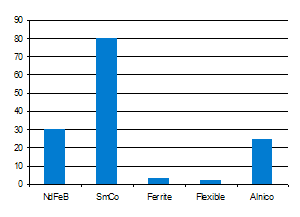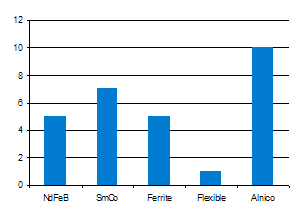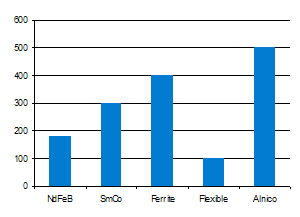Magnet Materials

Contents
- 1.0 Magnet Materials
- 2.0 Material Comparisons
- 3.0 Magnetic Strength
- 4.0 Magnetic Ratings
- 5.0 Magnetic Properties
- 6.0 Maximum Operating Temperatures
1.0 What Magnet Materials Can I Choose From?
There are five families of magnetic materials that you can choose from. These are, in order of increasing magnetic strength, the Flexible, Ceramic, Alnico, Samarium Cobalt, and Neodymium types. The information below summarizes the properties of each type to help you decide what you might need.
Flexible Magnets
Flexible magnets are a special form of ferrite or rare-earth magnet materials, manufactured by binding ferrite or rare-earth magnet powders in a variety of carriers, such as vinyl.
- Characteristics: Flexible magnet material is like rubber, and either white or dark brown in color. This inexpensive material can be bent, coiled and twisted, and easy to cut with a knife or scissors. Both magnetic strips and magnetic sheets are available with double-sided adhesive tape for easy application to products. Materials laminated with white vinyl can be imprinted using silk screening or digital printing techniques.
- Sizes and Shapes: Magnetic strips measure up to 3” wide by 400’ long, and the typical thickness is 1/16”. Magnetic sheeting rolls are typically 24” wide, 100’ long, and the typical thickness ranges between 0.02” and 0.03”.
- Applications: labeling, signage, visual displays, premiums, adhering office supplies, business cards, DIY home projects, window treatments and more.
Ceramic Magnets
Ceramic (ferrite) magnets are composed of barium or strontium ferrite, and the most widely used, lowest-cost magnet material available today.
- Characteristics: Relatively high in magnetic strength, and exhibiting good resistance to demagnetization, ceramic magnets are popular for many consumer applications. This material is hard, brittle, and dark gray in color.
- Sizes and Shapes: Discs, rings, blocks and arc segment forms.
- Applications: Commonly used for crafts, holding latches, toys, motors and more.
Alnico Magnets
Alnico magnets are composed of aluminum, nickel, and cobalt, and have been popular since the 1930’s. Alnico magnets are used primarily in technical applications, where temperature stability is critical.
- Characteristics: Excellent for high temperature applications up to 1,000°F, high residual induction, and corrosion resistant. Cast alnico magnets can also be produced in relatively complex shapes.
- Sizes and Shapes: Discs, Rods, bars, and horseshoes.
- Applications: Commonly used in Meters, and for specialized holding, high-temperature applications.
Samarium Cobalt (SmCo) Magnets
Samarium Cobalt magnets are a class of rare-earth magnet materials that were introduced in the early 1970’s. Today, SmCo magnets are most often used in applications which require elevated temperatures and the need for high magnetic properties.
- Characteristics: High magnetic properties, very brittle, but can be safely used at temperatures up to 500°F.
- Sizes and Shapes: Discs, Blocks, and rings.
- Applications: Generally used for more technically advanced and high-temperature applications.
Neodymium Iron Boron (NdFeB) Magnets
Neodymium magnets are rare-earth magnet materials with the highest magnetic properties. Composed of neodymium, iron & boron, these strong permanent magnets are the most powerful class of magnet materials commercially available today.
- Characteristics: Not as brittle as SmCo, but should not be used at temperatures above 300°F, without special design considerations. Neo magnet material may corrode easily under certain conditions, so it’s best to protect the surface by plating or coating.
- Sizes and Shapes: Discs, blocks, rings and rods.
- Applications: Ideal for both industrial, and non-technical applications such as holding, magnetic jewelry, clasps and more.
In addition to the families noted above, there are various grades within each family. For most non-technical applications, the grade is not terribly important. The magnets shown on the MagnetShop.com site are chosen for economy and for general applications.
2.0 Material Comparisons


Relative Cost By Weight / Relative Cost By BHmax


Difficulty to Machine / Maximum Operating Temperature
3.0 Which are the strongest magnets?
The most powerful magnets available today are the Rare Earths types. Of the Rare Earths, Neodymium-Iron-Boron magnets are the strongest. However, at elevated temperatures (of approximately 200 degrees C and above), Samarium Cobalt magnets can be stronger than the Neodymium-Iron-Boron types (depending on the magnetic circuit).
4.0 How are magnets rated?
- Residual Induction (given the symbol Br, and measured in Gauss). This is an indication of how strong the magnet is capable of being.
- Coercive Force (given the symbol Hc, and measured in Oersteds). This is an indication of how difficult it is to demagnetize the magnet.
- Maximum Energy Product (given the symbol BHmax, and measured in Gauss-Oersteds). This is an indication of what volume of magnet material is required to project a given level of magnetic flux.
5.0 What are the properties of commonly used magnet materials?
Here are the three important properties that characterize magnets for some of the most common magnet materials used today.

How can I use this information?
Given a magnet size, you can estimate how much magnetic flux different materials will project at a given distance or you can use this information to compare one material to another.
Example: How much more flux will a Neo 35 project as compared to a Ceramic 5 of the same dimension at a given distance?
Simply divide the Br of Neo 35 by the Br of Ceramic 5 (12,300/3,950) to get 3.1. This means that the Neo 35 would give you 3.1 times the flux a Ceramic 5 the same size would at a given distance. Given a certain flux required at some fixed distance from the magnet, you can use this information to estimate what magnet volume will be required for different magnet materials.
Example: What volume of a Ceramic 5 magnet would give the same flux as a Neo 35 magnet at a given distance?
Simply divide the BHmax of Neo 35 by the BHmax of Ceramic 5 (35/3.6) to get 9.7. This means that the volume of the Ceramic 5 magnet would have to be 9.7 times that of the Neo 35 magnet to give you the same flux.
6.0 What are the maximum recommended operating temperatures for different magnet materials?
The maximum temperature that a magnet may be effectively used at depends greatly on the magnetic circuit the magnet is operating in. Shown here are approximate maximum operating temperatures for the various classes of magnet material. At temperatures close to those listed here, special attention may be needed in order to ensure that the magnet will not become demagnetized.








